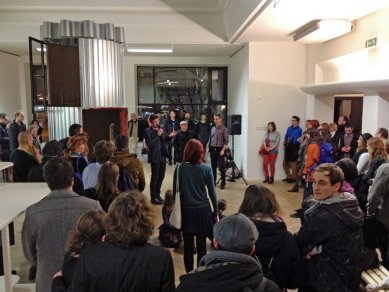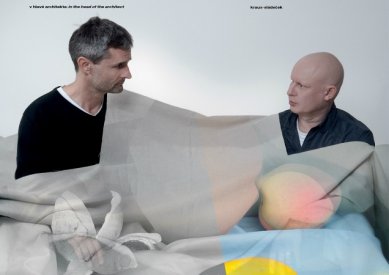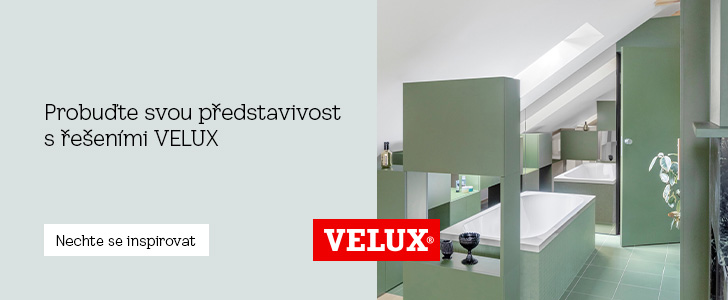
In the Architect's Mind / Kraus - Sládeček - Commented Tour
Source
Dům umění města Brna
Dům umění města Brna
Publisher
Tisková zpráva
04.04.2016 21:15
Tisková zpráva
04.04.2016 21:15
Svatopluk Sládeček
David Kraus
Commented tour of the exhibition with curator Rostislav Koryčánek, followed by a screening of documentary films produced by ČT about both authors - David Kraus and Svatopluk Sládeček. Admission 20 CZK
Commented tour on April 6, 2016 at 5:00 PM
House of Arts of the City of Brno, Malinovského nám. 2, Brno
Exhibition period March 9 - May 1, 2016
The meeting of two architects David Kraus and Svatopluk Sládeček at the exhibition "In the Architect's Mind" becomes a specific gallery event. It is the culmination of a personal level of a shared story that started relatively recently. The initial motivation for their closeness was mutual professional respect for the attitudes and realizations that each of them can boast about. Apart from the experienced professional closeness, Kraus and Sládeček share a unique and generationally non-transferable experience during their gallery rendezvous, which is the euphoria of discovering possibilities that expanded in the first half of the 1990s in our country. What could only be suspected or observed through the torn seams of the Iron Curtain in socialist Czechoslovakia suddenly became real and present after 1989. The intensity and amount of stimuli that could be experienced in all spheres of social, cultural, and political life can be compared to switching from a garden swing to a roller coaster at an amusement park. This period significantly shaped Kraus and Sládeček’s perception of architecture and essentially set their distinctiveness, based on the conviction that order is meant to continually test its validity. The euphoria of the early 90s can help us understand how it is possible for two very differently situated and founded personalities, who did not meet in person during their studies, to find so many ideological and creative similarities.
Distinctiveness, casualness, stubbornness, or programmatic opposition are some of the possible characteristics that could be attributed to Kraus, as well as to Sládeček, if we wanted to classify these architects within the current architectural scene. Other, less visible traits include an interest in the periphery, which both perceive as a space of expressive freedom and immediacy. The vitality of organizing the edges of cities and the dissimilarity that prevails at peripheral locations creates a specific poetics, which serves as a source of inspiration for each of them.
Their inclination towards situations and events at the edge is also related to their stylistic indefiniteness or openness to the materials used and their combinations. The choice of materials is more dependent on the economics of the construction than on the aesthetic qualities of the materials. While it cannot be claimed that the aesthetics of the construction or its expression plays a minor role for Kraus and Sládeček, the most pressing quality is the architectural space. The architectural space elicits the relationship of the human body to its immediate surroundings, and in the interpretation of both architects, it does not matter whether it is formed with drywall panels or an onyx wall. When walking through the realized buildings of Kraus and Sládeček, this is actually the first thing that comes to a viewer's mind, as they realize that each of them is an attempt to answer the question of what architecture can do without if the main content of the house is architectural space.
The insistence on architectural space and the search for opportunities to fill it also requires a special strategy in locating assignments. The domain of both architects is small builders who have decided to build or modify their own home. Kraus, similar to Sládeček, uses such intentions to invest architectural space into the designed building, just like a cuckoo laying its eggs in foreign nests. This does not mean that they programmatically avoid larger contracts; family buildings are simply the most suitable and accessible format for exercising architectural passion.
The similarity of the hierarchy of architectural values, where the architectural space, aesthetic composition, conceptual approach to solving a given task, or formal and material independence rank among the first, is the reason for the meeting of Kraus and Sládeček in the exhibition space. Referring to the tinkering and crafting, which is typical not only for the landscape of urban peripheries, each architect designed an object meant to interpret and characterize the architectural work of the other. The basis of the mutual interpretation is the selection of four buildings that Kraus admires in Sládeček's work and vice versa. What has emerged in the exhibition space is a kind of spatial collage that serves as a probe into the minds of both architects, emphasizing the main principles, motives, and sources of inspiration that they believe support the other. The assembled objects and the established dialogue between them also show that architecture is not a destructive fate for both architects but an open story that can be told in multiple ways without losing its persuasiveness and appeal. On the contrary, playfulness is a way to reveal another horizon.
More information >
Commented tour on April 6, 2016 at 5:00 PM
House of Arts of the City of Brno, Malinovského nám. 2, Brno
Exhibition period March 9 - May 1, 2016
The meeting of two architects David Kraus and Svatopluk Sládeček at the exhibition "In the Architect's Mind" becomes a specific gallery event. It is the culmination of a personal level of a shared story that started relatively recently. The initial motivation for their closeness was mutual professional respect for the attitudes and realizations that each of them can boast about. Apart from the experienced professional closeness, Kraus and Sládeček share a unique and generationally non-transferable experience during their gallery rendezvous, which is the euphoria of discovering possibilities that expanded in the first half of the 1990s in our country. What could only be suspected or observed through the torn seams of the Iron Curtain in socialist Czechoslovakia suddenly became real and present after 1989. The intensity and amount of stimuli that could be experienced in all spheres of social, cultural, and political life can be compared to switching from a garden swing to a roller coaster at an amusement park. This period significantly shaped Kraus and Sládeček’s perception of architecture and essentially set their distinctiveness, based on the conviction that order is meant to continually test its validity. The euphoria of the early 90s can help us understand how it is possible for two very differently situated and founded personalities, who did not meet in person during their studies, to find so many ideological and creative similarities.
Distinctiveness, casualness, stubbornness, or programmatic opposition are some of the possible characteristics that could be attributed to Kraus, as well as to Sládeček, if we wanted to classify these architects within the current architectural scene. Other, less visible traits include an interest in the periphery, which both perceive as a space of expressive freedom and immediacy. The vitality of organizing the edges of cities and the dissimilarity that prevails at peripheral locations creates a specific poetics, which serves as a source of inspiration for each of them.
Their inclination towards situations and events at the edge is also related to their stylistic indefiniteness or openness to the materials used and their combinations. The choice of materials is more dependent on the economics of the construction than on the aesthetic qualities of the materials. While it cannot be claimed that the aesthetics of the construction or its expression plays a minor role for Kraus and Sládeček, the most pressing quality is the architectural space. The architectural space elicits the relationship of the human body to its immediate surroundings, and in the interpretation of both architects, it does not matter whether it is formed with drywall panels or an onyx wall. When walking through the realized buildings of Kraus and Sládeček, this is actually the first thing that comes to a viewer's mind, as they realize that each of them is an attempt to answer the question of what architecture can do without if the main content of the house is architectural space.
The insistence on architectural space and the search for opportunities to fill it also requires a special strategy in locating assignments. The domain of both architects is small builders who have decided to build or modify their own home. Kraus, similar to Sládeček, uses such intentions to invest architectural space into the designed building, just like a cuckoo laying its eggs in foreign nests. This does not mean that they programmatically avoid larger contracts; family buildings are simply the most suitable and accessible format for exercising architectural passion.
The similarity of the hierarchy of architectural values, where the architectural space, aesthetic composition, conceptual approach to solving a given task, or formal and material independence rank among the first, is the reason for the meeting of Kraus and Sládeček in the exhibition space. Referring to the tinkering and crafting, which is typical not only for the landscape of urban peripheries, each architect designed an object meant to interpret and characterize the architectural work of the other. The basis of the mutual interpretation is the selection of four buildings that Kraus admires in Sládeček's work and vice versa. What has emerged in the exhibition space is a kind of spatial collage that serves as a probe into the minds of both architects, emphasizing the main principles, motives, and sources of inspiration that they believe support the other. The assembled objects and the established dialogue between them also show that architecture is not a destructive fate for both architects but an open story that can be told in multiple ways without losing its persuasiveness and appeal. On the contrary, playfulness is a way to reveal another horizon.
More information >
The English translation is powered by AI tool. Switch to Czech to view the original text source.













